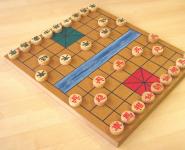checkers rules kick back
1. The game is played by two persons on a checkers board, divided into 64 squares, painted white and black, with 12 white checkers belonging to one player, and 12 black checkers belonging to another player.
2. The board between the players is placed so that the main road goes from the player from left to right.
3. Checkers on each side are placed in black squares on the first three rows from the player.
4. The moves are made alternately by the players.
5. A move is considered to be moving a checker forward to an adjacent black square, as well as capturing enemy checkers.
6. If the adjacent square is occupied by an enemy, say, black checker, and the black square following it is free, then the black checker "beats", i.e., the white checker jumps over the black checker behind it, which is a free black square, and the black checker " eat" - removed from the board.
7. At one time, as many checkers “beat” as there are on the way on the above conditions.
8. If it is possible to capture the opponent's checkers simultaneously in two directions, the choice, regardless of the number, is at the discretion of the taker.
9. When capturing, checkers are removed from the board only at the end of the move.
10. It is not allowed to take a checker twice in one move during a move (to cross it with a striker).
11. If the checker of one of the players during the game penetrates to the last row, then it turns into a king.

12. If a simple checker, when capturing the opponent's checkers, becomes a king and after that it again opens up the opportunity to beat the enemy checkers, then such a capture is obligatory (unlike Polish checkers).
13. The queen has the right to move along the entire length of the row of black squares to any place not occupied by checkers.
14. It “beats” the enemy checker if a free black square remains directly behind it. It strikes along the entire length of a row of black squares at any distance from itself.
15. Both a simple checker and a queen are required to “hit”, if an opportunity presents itself.
16. Both a simple and a king “hit” enemy checkers both forward and backward.
17. The winner of the game is the one who either takes all the opponent's checkers or deprives him of the opportunity to make any moves by locking the remaining checkers on the board.
18. If it is impossible for both sides to win the game, the game is considered a draw.
19. When the same moves are repeated three times directly on the one hand, the opponent is given the right to recognize the game as a draw.
20. When three queens fight against one, no more than 15 moves are given to win.
21. If there is one or more checkers with one king, no more than 30 moves are allowed to win, until the balance of forces changes.
22. If a win is not achieved in the last two cases, the game is considered a draw.
24. To record the checker's move, first mark the cell on which it stood, using the number and letter that correspond to this cell, put a dash and then attribute the name of the cell on which it stands in the same way.
25. If you need to indicate the removal of a checker from the board, then between the name of the cell from which the movement begins and the name of the cell on which the checker is placed after the battle, a colon is put instead of a dash (sometimes the sign X).
26. When fighting a row of checkers, only the beginning and end of the fight are indicated, omitting the intermediate cells.
Is it possible to eat back in checkers - the rules of different types of checkers

Checkers game rules. The answer to the question: "is it possible to beat back"
A question often arises before a beginner: you can’t go back, but what about the rules of the fight? Is it possible to eat backwards in checkers? Yes, you can! But not all rules of checkers games allow this. Find out more!
Checkers is a game that has always been popular. There are many varieties of checkers-type games, some of them are completely different from what we are used to. The rules there are special and quite complicated. We are interested in the classic game and its varieties. A fairly common question that worries beginners, is it possible to eat back in checkers?
Let's explain the basic rules: a simple checker, making one quiet move (one cell), can only move forward. But sometimes there is such a situation on the game board when you can beat the opponent's piece, but you need to hit back (i.e. jump over the game element of another player).
To finally figure out whether it is possible to hit back, we will give you a summary table of the main types that are close to the classic version (diagonal move).
You can choose any variety and follow the rules that suit you. That's why everyone likes this entertainment - interest never fades. If you love solving logic puzzles, this is for you!
Thus, an inexperienced drafts player hesitates: is it allowed to chop backwards when the main rule is forward and only forward? The answer is yes, but with some reservations. As you know, this game is loved all over the world. Varieties of the checkers game differ in their rules (although not significantly). Each pair of players decides for themselves whether to follow the established rules or not. Of course, if this is not a tournament, where everything is strict.
The most common types
Russian checkers have gained popularity in our country. It was her that our parents liked to play during breaks in the Soviet school. Yes, in Russian checkers you can cut back and eat any number of checkers in all directions. There are some regional differences in Russia. For example, in Stavropol, the ability to move with the opponent's checkers has been added, and in the northern ones, the king, when captured, is not removed from the board, but becomes a simple piece.
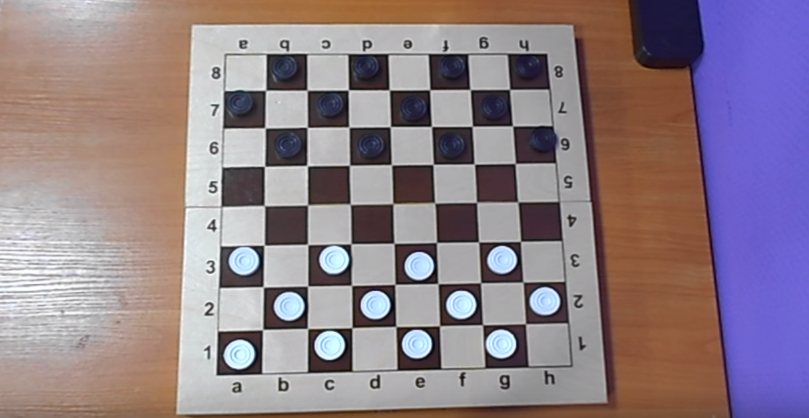
International Checkers - the name speaks for itself. The main difference is that the game is played on a board of one hundred cells in size, and the pieces line up in four rows. The board is large, but this increases the number of possible moves. Hitting back is allowed (however, a simple move is still forward). There is also another important difference: in the first, any piece that has reached the promotion square (the last opposite row of the board) becomes a king. In international ones, it is not in the process of eating the opponent's checkers.
Many countries around the world have their own rules. So, there are Brazilian, Italian, Canadian, German, Spanish, Portuguese, Turkish and Senegalese species. The differences, by the way, are minor. Except Turkish and Senegalese. Here the figures do not move diagonally, but in three directions straight. But not everywhere there is an opportunity to beat the opponent's checkers when moving back.
Also known English - checkers (Checkers). It is not allowed to beat the pieces that are behind on the playing field. And the king can only move one square in all directions. In the Italian variety, the king also moves to one square, and simple checkers cannot beat the king.
The pool game (Pool Checkers), like checkers, is popular in the USA. You can chop back, the lady is also free in her movements.
The checker type of game is a flexible system. Fans of mind sports have invented some original types of games:
- giveaways - the rules of the Russian type apply here, so there is no question whether it is possible to eat backwards in checkers. Need to! The main thing in this game is to succumb to the opponent, to allow all your pieces to be beaten or locked;
- Samoyeds - figures are eaten regardless of color (i.e. you also have to beat your own);
- two-way - players make two moves;
- diagonal - the initial arrangement is different;
- game on a board of eighty squares - you can hit back, like in Russians.
As well as other varieties that give a huge scope for logical research.
onlineshashki.ru
All news
Checkers rules
The game involves 2 players, each of them at the beginning of the game has 12 checkers (each player has a set of checkers of his color as standard white and black). The game is played on a standard chessboard (8×8) rotated so that in front of the player playing white in the lower left corner the cell (field) is black. During the game, only 32 fields (black) are used.
In the initial position, the checkers occupy 3 horizontal lines on each side.
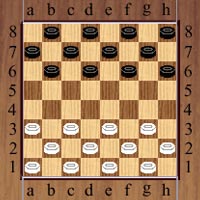
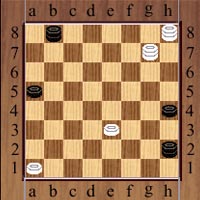
This picture shows the difference between the designations of primes and queens - on the fields a1, e3 there are white primes, on the fields h8, g7 white kings, on the fields a5, h4 black primes, on the fields b8 and h2 black kings. A simple one (in the initial position all checkers are simple) becomes a queen if the diagonal is reached in the process of the game.
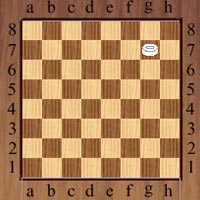
The white simple g7 can become a king next move by going either to the h8-square or to the f6-square.
A simple one can walk in two ways:
a) quiet move - moving forward diagonally to any free adjacent field (back quiet move is not carried out),

for example: in the initial position, white simple e3 can go to f4 or d4, while simple a3 has only one option on b4;
b) a fight - in which a simple can jump (hit, eat) over an opponent's simple or king, located on the adjacent field diagonally, provided that the field next along the same diagonal is free.
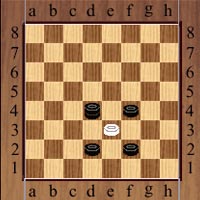
In the picture, white simple can capture in four directions on c1, g1, c5, g5.
If, after the battle, the striking checker has the opportunity to beat again, then the battle should be continued (the battle can be carried out in any direction, subject to the restrictions described in paragraph 2)
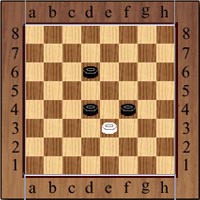
In the picture, white simple can beat in two directions either e3:c5:e7 or e3:g5. After the battle, the “beaten” checkers of the opponent are removed from the board.
A simple in the course of the battle who has reached the last diagonal becomes a king and, if possible, continues the fight as a king, according to the rules of battle for kings.
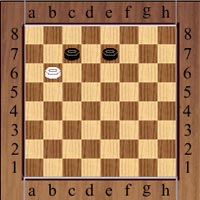
In the picture, white simple b6 can beat 2 checkers by ending the battle either on the f6 or g5 or h4 square, while turning into a king,
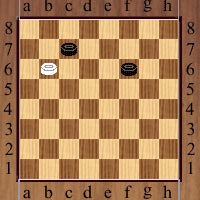
in this illustration, white simple b6 can capture 2 checkers by ending the battle either on the g5 or h4 square, while also turning into a king).
The king's move can also be of two types:
a) silent move - move in any direction diagonally, on any number of fields (only one direction at a time)
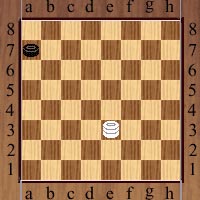
The white king can move in four directions to any of the squares g1, c1, d4, c5, b6, f2, d2, f4, g5, h6);
b) a fight - in which the king can jump over any simple or king of the opponent located in any direction from the beating king diagonally, if there is a free field behind it (a simple or king of the opponent) diagonally. If there are several free squares in a row behind the beating checker in the direction of the battle, then the beating queen can occupy any of them. If you can continue the battle from one or more of these fields, either in the same direction or perpendicular to it, then you need to do this in one of the directions (to choose from), and so on
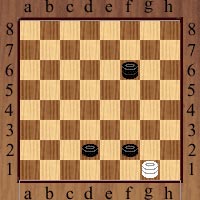
The white king has a choice of three battle options g1:e3:c1, g1:d4:g7, g1:d4:h8.
After the fight with the king, the “captured” checkers of the opponent are also removed from the board.
If, during the move of one of the players, it is possible to make several different quiet moves and not a single battle, then the player can choose any of the options (In the initial position, White has 7 options for quiet moves, and he can choose any).
If, during the course of one of the players, it is possible to make a battle and a few more quiet moves, then it is necessary to beat.
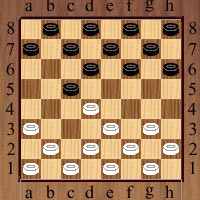
Let's make a couple of moves from the initial position c3 - d4, b6 - c5 - now it is absolutely necessary for White to beat d4:b6.
If there are several different fights and several silent moves, then you need to choose any of the fights.
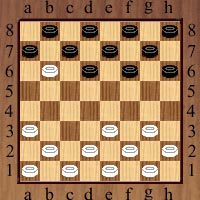
Black's move and he has to choose from two fights a7: c5 or c7: a5.
If the move was not made according to the rules, then it is necessary to make the move again, if possible, with the same checker.
During the battle, checkers are removed after the end of the move (Turkish strike)
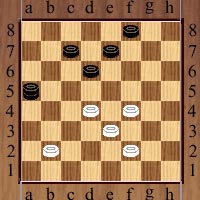
Here White has a wonderful opportunity to win 1.b2-c3 Black must capture 1... a5:e1:g3:e5 and the d4-checker cannot be captured, after which White captures 2. d4:f6:d8:a5 with a win.
A checker cannot be hit more than once
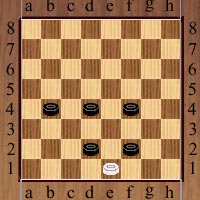
Here is a position in which White has several fighting options: e1:c3:a5; e1:c3:e5:g3:e1; e1:g3:e5:c3:e1; e1:g3:e5:c3:b4, however, all the opponent's checkers at once e1:c3:e5:g3:e1:a5 cannot be beaten by White, because in this variation the checker d2 is beaten twice, and this is forbidden.
Capture or lock (when the opponent moves, he has checkers, but they cannot make a single move) all of the opponent's checkers. If none of the opponents manages to achieve this, then a draw is awarded.
4. Notation and symbols.
Each field on the checkerboard has its own designation. To do this, the horizontal rows get numbers from 1, 2, 3, 4, 5, 6, 7, 8, and the vertical rows are denoted by Latin letters a, b, c, d, e, f, g, h. The field located at the intersection of the vertical d and horizontal 4 is designated as d4. According to a similar scheme, designations are given to all fields on the board.

A quiet checker move from the c3 field to the d4 field will be written as c3-d4 or cd4 (abbreviated notation),

the battle is denoted as e3:c5:e7 or e3:e7 or e:e7.
The entry 11.a3-b4 d6-e5 means that on the 11th move White went a3-b4 and Black answered d6-e5
P.S. Recently, Russian drafts competitions have been held in two versions - classic Russian drafts and the so-called. random draw tournaments.
The second option assumes the presence of an officially approved list of initial 2-3 moves (as well as the option when one checker of each side at the beginning of the game takes some other position - “flying” checkers). Before a game (or micro-match), the opponents determine the number of the opening or starting position by lot. This version of the board game was developed by leading Russian grandmasters in order to "revive" the game and avoid the alleged "drawn death" of Russian checkers, where theoretical developments have reached a critical threshold. The list of openings and positions used in such tournaments is constantly reviewed and approved by the RFS every two years.
The rules completely coincide with the rules of Russian checkers, but the initial arrangement is different.
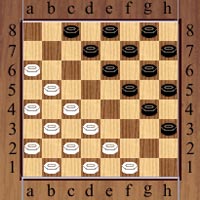
The rules are similar to Russian checkers, but the board is 10 squares wide and 8 high.
The rules of the game coincide with the checkers rules, but differ in that the beaten checker of the opponent is not removed from the board, but climbs under the beating tower, and if the tower is beaten, then only the top checker is removed from it! If several checkers of the opponent fight, then they climb one after another and a “tower” (“pillar”) is formed on the final field. The tower moves all at once and moves according to the rules of its upper checker, like a simple or king. The tower, like a single checker, can go to the kings, and only the top checker becomes a king. When a tower is captured, one top checker is removed from it, and the checker below it comes into play in accordance with its color. As a result, the player can release his checkers captured earlier by the opponent, and the king previously captured and subsequently released is a simple one.
The game is played on a board of 10x10 cells. Checkers occupy the first four rows on each side, located on dark cells.
Opponents take turns moving pieces of their color. An ordinary checker (at the beginning of the game all checkers are ordinary) can make two types of moves:
- Quiet move - moving the checker one field forward diagonally. According to the rules of the game, a quiet move is possible if the corresponding field is free and nowhere on the board is it required to capture the opponent's checker.
- Taking the opponent's checker - moving the checker two spaces forward or backward diagonally, while jumping over the opponent's checker, which is then removed from the board (a simple checker can hit back).
In international drafts, unlike Russian, when fighting with a simple checker through the “transformation field” (one of the fields of the horizontal farthest from the player), it does not turn into a queen, and continues the fight according to the rules of a simple one.
When an ordinary checker reaches the last horizontal line, it becomes a king. Kings are able to move an arbitrary number of fields diagonally, both forward and backward.
According to the rules of the game of international checkers, capturing the opponent's checkers is obligatory. If, after capturing one, it is possible to beat another opponent's checker, the capture continues. If there are several options for beating, it is necessary to beat the maximum possible number of checkers.
In international drafts, the winner is the one who managed to destroy or block the movement of all the opponent's checkers.
The game is played on an 8x8 board. Each player has nine checkers, which are arranged in the form of a 3x3 square in the first near (for each) corner of the board. In a board game, the corners of a checker move to one cell adjacent horizontally or vertically, or jump over a chip that stands on an adjacent (horizontally or vertically) cell, if there is free space behind it. In checkers corners, the one who first occupies the opponent's corner wins.
The rules of the game of checkers-giveaway are similar to the rules of Russian or international checkers, only the goal of the game is to give or lock all your checkers.
Checkers is the most popular board game in the United States. The rules of the game in Checkers are very similar to the rules of the game in Russian checkers, but they have the following differences:
- a simple checker cannot hit back;
- the queen can only move one square in any direction;
- you can beat an arbitrary number of checkers.
Moscow, st. Lodochnaya, 6
Call us on our phone:
(495) 518-70-62
www.rovertime.ru
Russian checkers online
In the most concise statement, the rules of the game are as follows: the game is played on a board of 8 x 8 cells,
checkers occupy the first three rows on each side; you can hit randomly
the number of checkers in any direction; simple can beat back, lady can
walk on any number of fields; The object of the game is to capture or capture all of the opponent's checkers.
Let's now consider these rules in more detail:
Playing field. Starting position
The playing field is a square board of 8×8 cells, similar to a chessboard. Verticals (columns) are denoted by Latin letters from a to h, and horizontals (rows) by numbers from 1 to 8. Unlike chess, not
everything, but only dark fields (in the program they are displayed in green).
For example, the field a1 is playable, but the field c4 is not.
The side that manages to destroy or block the movement of all
opponent's checkers.
== Simple checkers ==
At the beginning of the game, all checkers are simple (see the figure).
A simple checker can make, depending on the position, types of moves: quiet and percussive.
- Quiet move - move one space forward diagonally. A quiet move is possible if the corresponding field is free and nowhere on the board is it required to capture the opponent's checker. For example, the correct move from the initial position would be to move the checker from the c3 square to, for example, d4 (in the notation of the game, this is denoted as c3-d4), or to b4 (c3-b4).
- Striking move (battle of the opponent's checker) - moving two squares forward or backward diagonally, through the opponent's checker. A checker during its move must beat (take) an opponent’s checker if it is located on the adjacent (diagonally) field and if the field following it is free. The capturing checker stands on this free field, jumping over the enemy checker, which is removed from the board. The capture can be made not only forward, but also backward.
If, after capturing one checker, it becomes possible to beat another checker of the opponent,
the capture continues, that is, in one step (in one move), the checker must hit as many
opponent's checkers, how many of them are on her way. Captures in Russian checkers are obligatory.
With the possibility of taking in different directions, the choice, regardless of the number
or the quality of the checkers being removed is given to the taking player. When taking several
you can only remove the opponent's checkers from the board after the end of your shock move.
When capturing, it is forbidden to jump more than once with a striking checker (lady) over one
and the same checker of the opponent (but it is allowed to step on a free field several times).
== Ladies ==
If a simple checker reaches the last horizontal, it becomes a queen. ladies,
unlike ordinary checkers, they are able to move to an arbitrary number of fields along
selected diagonal, both forward and backward.
The queen during her move is obliged to take the opponent's checker (both forward and backward)
regardless of the number of free fields before it, if only this checker is
on the same diagonal with the king and behind this checker there is one or more free fields.
Moreover, in the latter case, the queen, having captured the opponent's checkers, can stop at any of them.
If, when capturing, there are also checkers of the opponent on any of the intersecting diagonals,
behind which there are free squares, then the king is obliged to continue capturing these checkers,
no matter how many are in her way.
Just as in the case of simple checkers, if there are several ways to perform
shock move (with the same or different kings), the choice of the latter is left to the taking player.
If an ordinary checker reaches the last horizontal as a result of the battle of the opponent's checkers
(where she is supposed to turn into a lady), and if she is given the opportunity to further
captures enemy checkers, then she is obliged to continue the battle in the same move, but already as a king.
Please note: this rule only applies if the checker reaches the last
horizontal as a result of the shock stroke. In case a simple checker reaches the last
a row without a capture and after that she will have the opportunity to fight, then she must beat (if such
the opportunity will remain) only on the next move.
Checkers rules? Arguing with your son - does the saber cut back? And how can a lady cut?) Tell me please))
There is no checker and pawn... :)))))
But the lady can.
It was also interesting..
Main article: Russian checkers
A board of 8×8 cells is used. Each player in the initial position has 12 pieces - the so-called simple checkers, which occupy the first three rows on each side. During the game, the checkers move along the black squares, they can only land on unoccupied squares. A simple checker can move diagonally forward one square and hit back and forth (in this case, the checker moves diagonally two squares, jumping over the opponent’s checker or king, which is removed from the board; if from the new position of the attacking checker it is possible to beat another opponent’s checker, the move continues, etc.). Upon reaching the queen square (any square of the last horizontal) or when fighting through the queen square, a simple checker turns into a king and continues the fight according to the rules of the king (now it can move to any number of squares diagonally in any direction). In one move, the opponent's checker can be beaten only once (Turkish strike rule). According to this rule, if during the battle of several checkers of the opponent, a checker or king re-enters an already beaten checker, then the move stops. Beaten checkers of the opponent are removed only after the end of the move. The player on his move is obliged to beat the opponent's checker, if he has such an opportunity, but with several options for the battle, the player is free to choose any. Passing is not allowed. The goal of the game is to capture or "lock" (deprive the possibility of a move) all of the opponent's checkers.
Recently, competitions in Russian drafts have been held in two versions: classic Russian drafts and the so-called. random draw tournaments. The second option assumes the presence of an officially approved list of initial two or three moves (there is also a variant of "flying" checkers, in which one checker from each side in the initial position occupies some other position).
back checkers chop
but with the king, everything is much more interesting - the king cuts back along the length of the entire diagonal, while continuing the move (cutting) of the checker, when it turns into a king on the last field in Russian drafts and international drafts, it differs:
Russian checkers (64 cells): The queen can move to any number of squares, when fighting a simple battle, she becomes a queen through the transformation field and continues the fight as a king.
International checkers (100 squares): King can move to any number of squares, when fighting through the transformation field, a simple does not become a king and continues the fight as a simple one.
Solving problems in TOE, OTC, Higher Mathematics, Physics, Programming. § 3. RANDOM VARIABLES 5. Normal distribution. A random variable is said to be normally distributed, or follows a Gaussian distribution, […]
